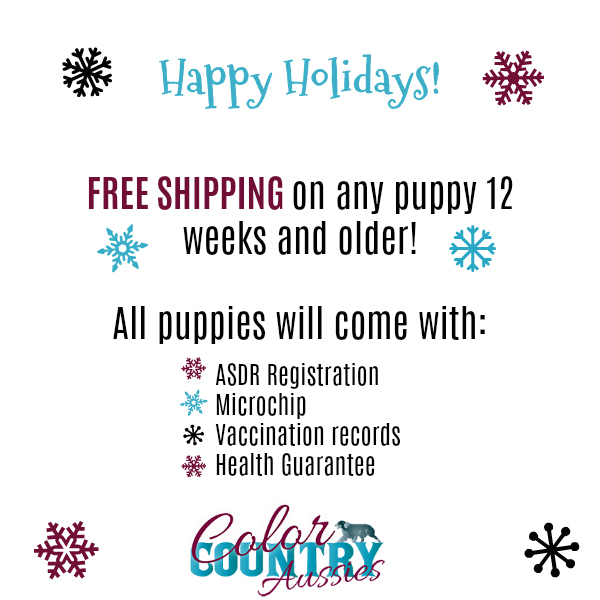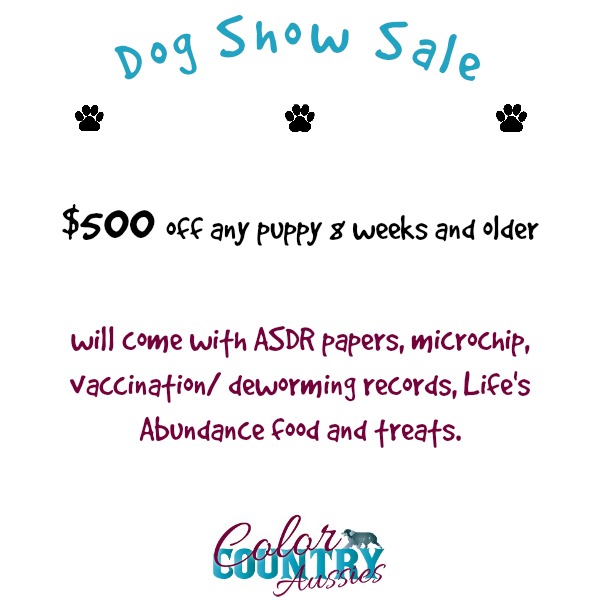
How should I socialize my puppy?
Let me start out by saying the critical period for socializing any dog ends at 16 weeks of age. What happens to the puppy before that age will have more impact on the adult dog he becomes, than anything that happens later. That does not mean that if you have any training issues that they cannot be worked out after that age but that you should give your puppy a good foundation to grow on. So, if a breeder keeps the puppies kenneled outside during that time, rather than raising them in the home and taking them out for various socializing and training opportunities, the puppies may never be able to reach their full potential. I can’t stress this enough. It is critical that a puppy in a home with his new owner, and any puppy still with his breeder, is properly and extensively socialized to all sorts of people including children, to other pets, and to many different situations he will encounter in a normal life with humans! I work with my dogs daily in several situations and around several people as well as animals. There are many, many articles and studies that have been done in this topic, so if you want to read more, you can do a search on the web for phrases like “critical period for socialization in canines.” Even after 16 weeks of age, it is still very important to consider a well thought out socialization plan.
What is socialization? You hear that term tossed around a lot, but what does it really mean? Socialization doesn’t just mean taking your dog in public, or exposing him to a certain number or type of people. It means getting him used to all sorts of handling such as having his feet, mouth and ears touched, being restrained for grooming or medical treatment and many other things. Since we are show breeders your puppy will be used to being bathed groomed and stacked on a table. I like for my dogs to think on their own and let them explore dangers with me by their side just in case they need me to help them make the better decision. It is kind of like raising your own human children “but easierJ”. Try and get them exposed to a huge variety of situations, noises, people and other animals, and many other things, so he will be well rounded and confident in his life. This means household noises like a vacuum cleaner, the TV or radio, noisy kids playing, and so on.
I try to make sure my dogs meet at least a dozen new people a week during the first year of life. I want to get them around tall people, short people, men with beards, people in hats or shiny sunglasses, loud people, quiet people, people of different races, people in “funny” clothes, kids, older folks and so on. I groom them regularly and make handling for medical treatment part of our regular social time. By that I mean I may practice holding them in various ways such as they may need to have blood drawn and so on. That way when it’s time to have treatment at the vet, they are more used to it.
Australian Shepherd pups need plenty of sensible, controlled socializing from birth on, if they are to reach their full potential. As a breed, as per the standard, they may be reserved with strangers and possess strong guardian instincts. What does this mean to a pet owner? If not well bred, raised and socialized, you may have a dog who is overly protective of its home and family, or overly fearful. This takes a lot of the fun out of owning a dog, not to mention is a major liability. Even well raised and socialized Aussies may possess some of these qualities, but the purpose of this article is to help an owner minimize that to the point the dog is a joy to live with.
Socializing should start before your puppy comes home. As a breeder, we are hands on with the pups from birth to the point the pup is transferred to its new home. Ideally that would mean the pups are born inside and handled daily, and exposed to all sorts of sights, sounds, smells and experiences. I am doing Early Neurological Stimulation, from days 3-16, and I handle them daily in other ways as well. I wait until my pup has his first shot before any outside people can handle them. I as well as my staff handle every puppy every day. Same for vet visits, they are carried in to avoid being on the floor or ground, until they have completed their shots. The most critical time to expose your puppy to as much as possible, but in a safe, controlled way, is 8-16 wks. I can’t stress this enough, as this is what will determine a large part of how your puppy will turn out!
Another concept with socializing I want to discuss is HOW to do it. Many people almost force their pup to meet new people, even when the experience is clearly overwhelming for the pup. I try to keep a close tab on how my pup is feeling. I let them have some say in how much contact they have with new things, at first. I think it builds confidence for them to decide how to relate to things, and I set them up to succeed by trying not to put them in situations they aren’t ready to experience, but I reward them (often with food) for exploring and visiting. Once they’ve had all their shots, I may take them in the local big farm store. I will take my homemade treats and give them to employees to hand out and it encourages dogs to want to go up to greet new people. I don’t force them to accept petting if they aren’t comfortable, but let them set the pace. Most of the time it’s more about holding them back though, as they want to see people to get treats. The reason I use caution and not force them is I have seen several dogs really damaged by that, by being flooded with more than they can handle. You must have a balance of positive experiences at this stage, to get an ideal outcome. Your puppy needs to trust that you will not put him in a situation that is too much for him to handle. If you damage that trust by forcing him at a young age, you may never fully get it back.
IMPORTANT: Something you don’t want to do is reward fear or caution by cooing to the dog, trying to reassure it with soothing words or petting. That simply reinforces their fear or uncertainty. Many dogs, Aussies included, may go through fear periods as they grow, meaning your normally outgoing puppy suddenly acts afraid of a new person or situation, or even things it used to be fine with. A lot of people try to comfort the dog, but that simply reinforces the emotion and behavior.
What I tend to do is pretend to ignore their fear, as if I am saying “I don’t have a clue why you are acting like that, you silly thing, there’s nothing to be afraid of.” It’s sort of like being matter of fact rather than feeding the fear. I guess it’s like if you have a toddler who is running across the floor and falls. You can gasp in horror in which case the child will probably start crying, or you can laugh, in which case the child will also laugh. Just like that child, your dog will feed off your reactions more than you will ever know.
If I have a dog going through a fear period, I keep taking them everywhere and have people feed treats. I don’t happy talk the dog, or do anything that may make them I approve of them showing any hesitation, but I sometimes look straight ahead at whatever we are doing, expecting the dog to come right along, as if it never occurred to me they may even consider being afraid. Aussies are so keen at sensing our emotions and reacting based on that. Staying consistent will also help you in building confidence in these dogs. You can also call me at any time and ask questions I am always available for my puppy customers.
Of course, if you can enroll your puppy in a reward based, quality training class, that is great. I highly recommend it! I think that working agility and herding as well as other aussie events will help you in the training and building confidence in your puppy. In some places those types of classes are easy to find, in others they are harder. Find a trainer who is familiar with the breed and comfortable in working with them. Watch a class before enrolling, if you can. If at any point, you feel uncomfortable with the methods used, don’t take your pup there. Even if you have already started a program, the same applies. Never let a trainer do something to your dog, or instruct you to, that makes the dog afraid of you or other people, or damages the trust and confidence you are building. You are the parent and do not let anyone do anything to or with your dog that you or your dog is uncomfortable doing.
The other thing you must do is understand the concept of management. Even a “good” Aussie may find situations or people he or she just doesn’t like. Rather than trying to force the dog to behave in such a situation, don’t be afraid to simply remove the dog. If your Aussie wants to “help” you or “protect” you from your friends, or your children from their friends, it’s better to just remove them rather than have the dog take matters into his own paws. You can keep working with the dog in that type of situation, but some may just find it too stimulating given their herding instincts. It’s better to remove the dog than have it bite! In an Aussie, chasing moving objects is a very self-rewarding behavior (meaning it feels good so it doesn’t need an outside reward like praise or treats.) The more they practice it, the more they will do it. So, the best thing to do is to remove the dog until you can train to have more control over the dog, and the dog can learn more self-control in that situation. If it can’t learn that control, just don’t have the dog loose in those situations. It may be asking more than the dog can give.
One important concept I want everyone to understand is a dog is not a human nor should he be treated like one. You also need to be the Alpha do not ever let the dog train you and with Aussie this happened more than I would like to say. These dogs are very intelligent and can easily become the alpha in your home. Also, just like some humans don’t like EVERY person or situation he finds himself in, neither do dogs. Dogs never do things without a reason or without warning, but if their owners don’t understand them they may be blamed for that. It is the human who lacked the training or skill in observing and understanding. Most dogs want to please as it gives them the positive feedback from their owners, but not all dogs will be “perfect” in all situations. Love your dog anyway, and train him, don’t blame him!
HOW TO MEET A NEW DOG
I wanted to add some information for people to use to help them properly meet a new dog. This will apply to Aussies as well as any dog. You can use this info to coach people meeting your dog as you have him out to socialize. It is even more important to teach children how to properly meet and greet dogs.
So many people see a pretty dog and want to rush up to it, speaking in a high pitched or loud voice, and either pet or hug the dog. If you think about how the dog perceives this, you may realize this is not the right way to approach. Many dogs are threatened by a strange person rushing up to touch the dog, especially if the person is being loud and looming over the dog, or is trying to touch it. If you have properly introduced your dog to loud situations this may not be a huge concern but Aussies are naturally hesitant to a forced situation so make sure that you have control of the situation and remain calm and let the dog approach you. Don’t even try to make physical contact, and don’t talk to the dog. Instead, let the dog smell you and make the first contact. After the dog has done this, you may put your hand out to be sniffed. If the dog seems comfortable and accepting, reach under its jawline to give a scratch. So many people reach over the head of a dog, which is another potentially threatening gesture. Also, dogs don’t instinctively enjoy being patted on the head. The same goes for patting their ribs, something I see some men do at times, giving a hard couple thumps on the dog’s side. Instead, try scratching under the chin, on the chest or on the rump above the tail. These are places most dogs enjoy being petted. Unless you know the dog well don’t try to hug the dog. Always be aware and watch the dog’s behavior. Know that hugging is something people like to do, but dogs don’t naturally understand it as a sign of affection. In fact, in dogs, it is more likely to be used in a dominance interaction, where a dog may wrap its paws around the neck and shoulders of another dog to dominate it. It is especially risky for a child to try to hug a strange dog, as the dog may bite. Though people think it’s wrong for a dog to bite in that situation, it is a perfectly natural reaction for the dog.
By behaving in this manner around new dogs, you will find most react much better to you than they would if you played the obnoxious animal lover. And, you will be keeping yourself safe from a potential bite for doing something a dog is not comfortable with.
ADULTS AND PUPPIES
Something else that I consider VERY important in raising balanced dogs is that puppies get plenty of time with adults that have stable temperaments. At my house, my adult dogs are very appropriate with puppies and my puppies get many hours a day with them every day. I am careful at first when puppies are young, that they don’t get trampled when the big dogs play hard, but after that they are together almost all waking hours. Not all dogs like puppies and this is ok. I have some dogs that love to play with the puppies and I have other that will tolerate it but have limits. The puppies get to practice submission and if they push TOO hard, the adult may give a quick correction. We also have some of our adults that help us in the training in our puppies in both leash training as well as working and agility. We also have our adults that teach our puppies how to use the doggie door to go outside and teach them the do’s and don’ts of the house. I have found that the puppies learn very fast. Let’s use this as an example. I had Standard Aussie Red… She was a very loyal and obedient dog. I would tie some of my puppies to her as we were leash training and learning simple commands like come sit stay and down. These are commands that I think are the very first commands that a aussie needs. Red was very patient with the younger dogs and helped them almost like it was her job. She loved the puppies and loved helping me with them. It was always fun to watch her with them. But she did not love playing with the puppies she had not tolerance for puppy wallowing all over her and chasing her around but she was wonderful and knew that when she had a young dog tied to her she was to be at her best. I do have other dogs that help me with this but Red was my first to do it and was the very best at it. We also use Mystry, Cowboy, Jazz and the late Green Grass and Henley to help us with the herding. These dogs are very obedient and teach my puppies how to properly work the ducks.
Puppies raised with other dogs learn so much, but of course these must be dogs with the appropriate social skills themselves, or they may hurt the puppies. It takes both to raise stable dogs, good genes and proper upbringing. We try and raise a well-rounded and very social Aussie. Keep in mind these are aussie and they are not a one size fits all dogs. You can have dog from the same litter with the same upbringing and they are totally different. Just learn to know your dog and your dog’s behavior as just like humans we are all different.
To wrap this up, when you take on an Aussie puppy or adult, you are embarking on what should be a very rewarding partnership with an amazing breed of dog. It’s up to you to set the stage for success for your little canine genius! Help him be all he can be! Train, socialize and succeed!







